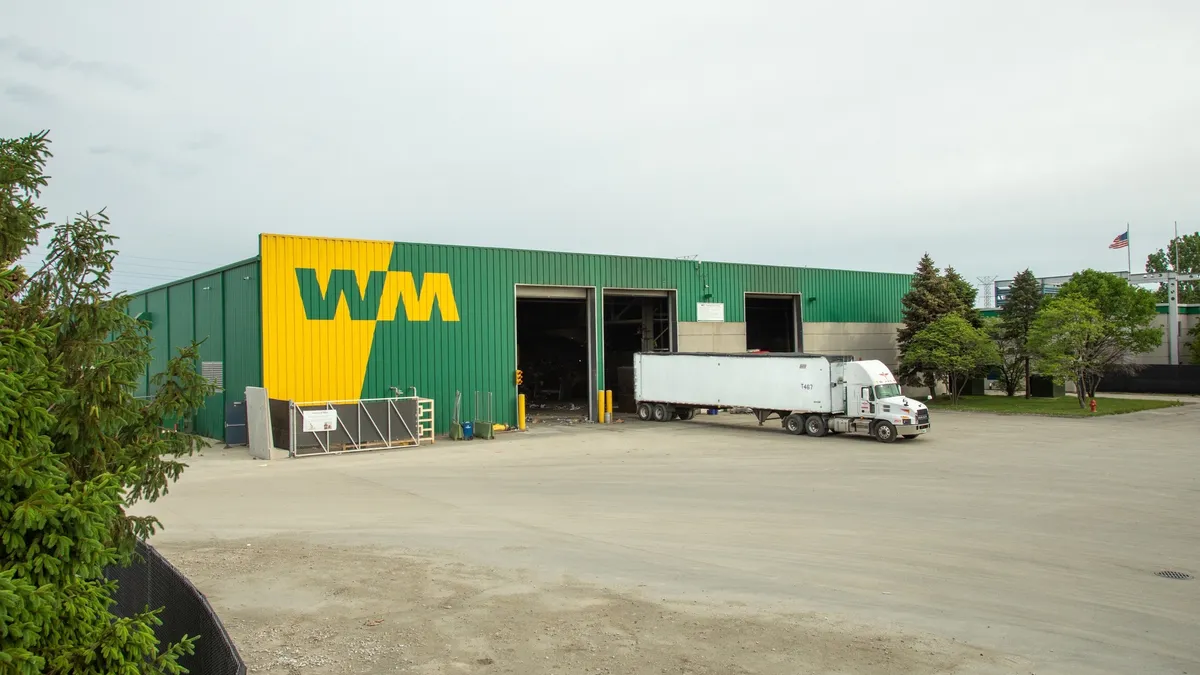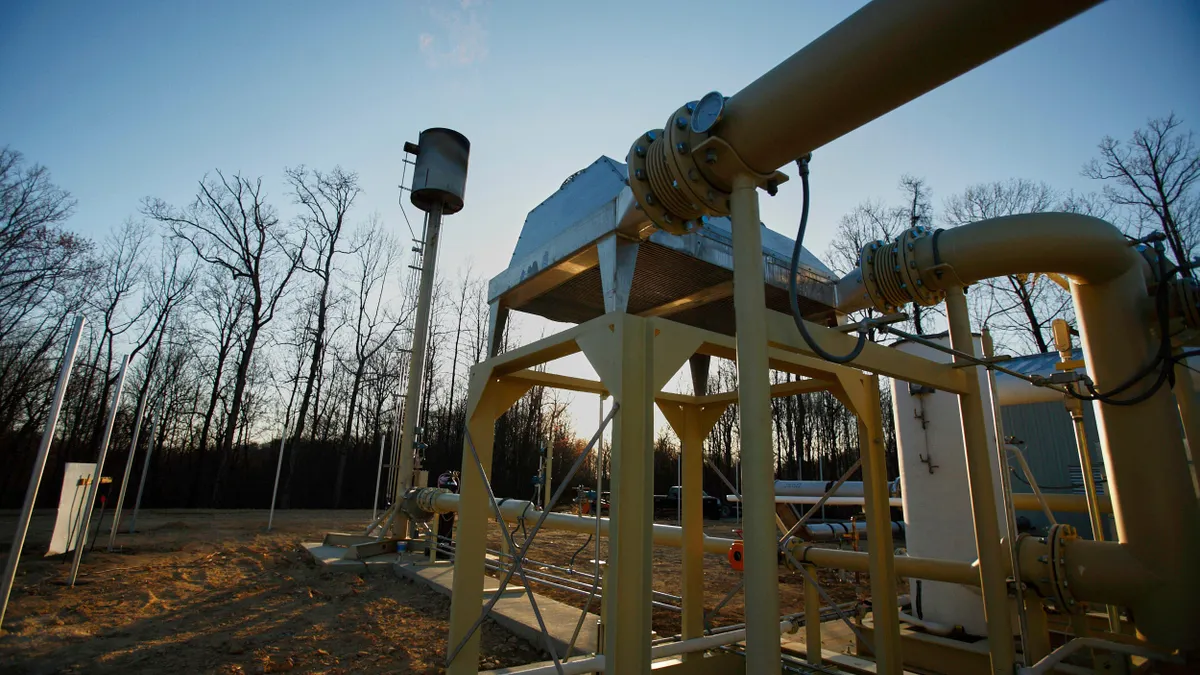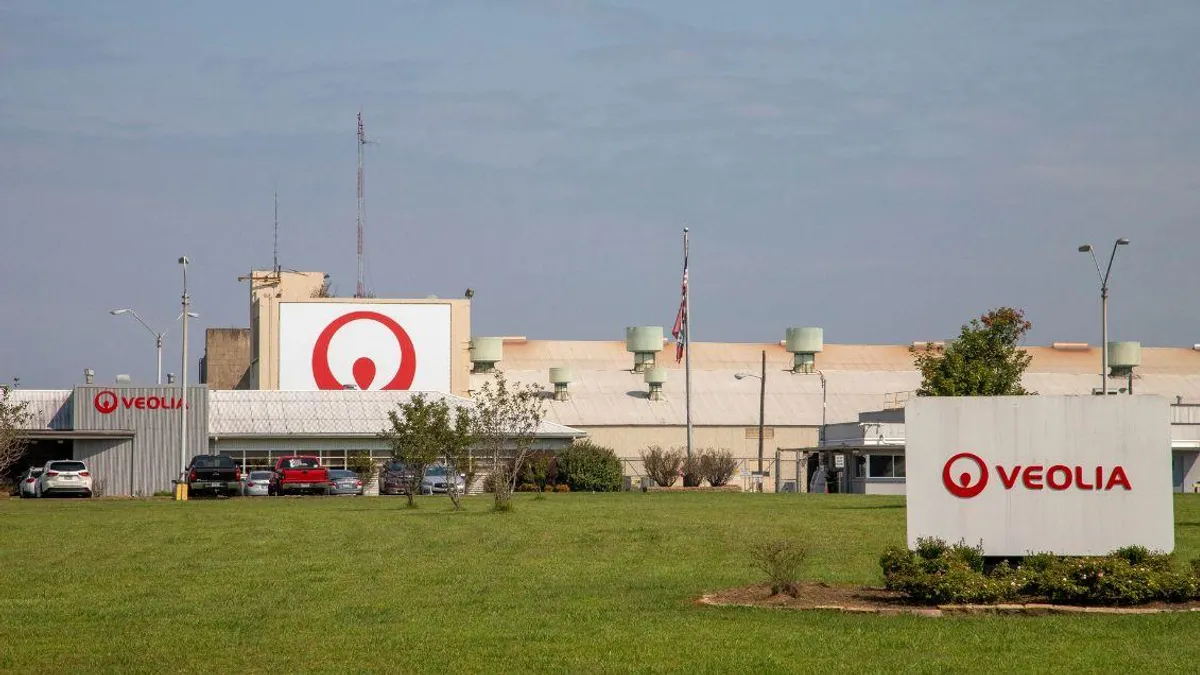As the waste and recycling industry continues to evolve, its largest company — WM — remains a key barometer for the pace of innovation and economic activity in the sector.
Following the company’s recent Q1 earnings report, CEO Jim Fish was in the spotlight during multiple sessions at last week’s WasteExpo. During a keynote session, Fish said one of his top goals for the year ahead was to ensure that big spending plans for renewable natural gas projects at landfills and MRF expansions — described as “critically important for us” — are rolled out smoothly. He also discussed how certain investments in automation can reduce the company’s labor costs through attrition, including the example of how turnover for MRF jobs can be as high as 40-50%.
Waste Dive spoke with Fish at the event to follow up on what’s next with the company’s approach to labor, organics recycling, fleet investments and other areas.
The following interview has been edited for length and clarity.
WASTE DIVE: Everyone seems to have different feelings about what’s going on with the economy, though we know the waste industry tends to be resilient. You’ve been with the company over 20 years and have seen prior downturns. What has changed in terms of WM’s foundation and ability to weather a possible downturn now, and what feels different about this one?

JIM FISH: It’s so hard to get a feel for what it actually is, because you hear different talking heads. Some will say, “Oh, my gosh, this is gonna be a hard landing.” Others are saying we're actually going to narrowly miss it. So I don't really know what happens. If anything happens, I think it'll be Q4 or Q1-Q2 of next year.
I do think the company's different than it was in ‘01 and then again in ‘08-09. We've changed our model a little bit, particularly as you think about recycling. When commodity prices were as low years ago as they are today we would have been constantly talking about it on earnings calls as “this is a huge headwind for us.” Going into the [latest earnings] call, as we were preparing, I said I don't even want to use the word headwind, because it feels like kind of an excuse.
We've changed the model quite a bit so that even though commodity prices are a bit soft, the recycling business still does fine. The solid waste business is not immune to downturns, but it sure does do well relative to other industries during a downturn.
I do think we're a leaner company. We're using technology as you've heard us talk about — not to replace people or let people go out of their jobs, but to replace them when they leave. So that I think is beneficial, especially as you're going into a downturn.
On the technology piece, I recall it being a big emphasis when you announced the chief digital officer role in 2017. How should we think about that setting the company up for what you’re able to do with automation now?
We've really focused on customer-facing automation. It’s not that unique, honestly, but it's something where the industry hasn't been as advanced as other industries. So as I think about how the customer interacts with us, they'd much rather interact on their digital device than call somebody.
I can't tell you the last time I called an airline. I think they actually charge you a fee for calling and talking to their reservations center. Our business was still more of a call center model. We started to migrate away from that with the advent of some of these technology platforms that enable customers to check the status of their payments, check the location of their vehicle, things that seem pretty simple.
If it's a complex customer with a lot of locations, they can still call in. In fact, anybody can call in. But a lot of people choose to use their digital device. So we're not telling people you can't call. We're just giving them potentially a better option, especially as you think about the younger generation.
My dad's generation still says, “I don't know how that thing works and I want to call.” But my daughter's generation ... they would much rather check the status of a payment or ETA or whatever it is via their device. And now we've taken out 25% of our calls. And with 25% of our calls, with a job that has almost 50% turnover, you don't have to lay anybody off. You just don't replace those positions. So it'll be close to 1,000 positions between ‘21, ‘22 and ‘23 that we just choose not to refill in our call centers. And we're going down a similar path on things like routing technologies.
So it sounds like you have everything you need in place for now in terms of technology. Are there any new platforms left to be rolled out in the near future?
I think the one that's the most complex is this routing and logistics technology. We all use our phones to find a restaurant when we're in Boston and that works really well. There's a lot more factors involved when you're a driver. There's low bridges and time stops at school zones and driver expertise, container type, truck type. There's a whole bunch of factors that go into it — traffic obviously is one — but all of those get crunched through this massive engine and it, in theory, spits out the best possible route.
But then things change dynamically as well. Not just up until the route takes off — because you can have a driver call in sick and so now you gotta reroute everything — but you can also have a tanker truck rolling over on an interstate and that creates challenges. We think this can provide [an increase of] as much as 10 to 15% productivity. But it's in a pilot stage right now. We're piloting in 35 locations, but we have 500 hauling locations, so we're not even in 10% yet. Once we get there, I think it's a huge benefit to us that helps us with this labor challenge.
It may not be 50% turnover with drivers, but it's 20% to 25%. So how do I handle that? One of the ways is to get more efficient via technology.
We’ve talked with WM before about how technology is helping to reduce labor needs at MRFs that are often staffed by temporary workers. The helper piece may be more challenging on collection routes, but is there a point where across these categories you don’t need much of a temp workforce anymore?
I guess it's possible. The temp workforce always helps supplement what we do today, particularly for some of those jobs — helper positions on the back of trucks, the pickers at recycling facilities. So I don't foresee a day where we don't use temp labor at all. But we have whittled away at it a bit.
Because that’s not cheap, I’m sure.
No. Of course, they have to make a margin. So if you think about how much we pay ... every single one of our employees is making above a certain threshold. And if you think about temp labor, they pay that threshold and then they charge their margin back to us. So it's not inexpensive.
As we think about not just temp labor, but some of these transportation providers, it's not technically temp labor, but it is a third-party service. For example, inner city type transfer stations, they've been passing through significant price increases to us. And I understand it. They have increasing labor costs as well. So we have to then, in turn, pass that through to our customers.
Last year you announced the Natura PCR deal as a way to get more involved in secondary processing for certain plastics. Yesterday at the investor summit, Republic Services mentioned it could look at processing opportunities for other material streams after completing its own polymer centers. Is it in the cards for WM to get into other streams for secondary processing beyond what you’re doing?
Natura I think is is one foray into that. Continuus [Materials] was another. I think for now, we're going to make sure that those work well. There still are some things we have to do to adjust and make sure that they're profitable. Because I've always said about sustainability, it's got to be both environmentally and economically viable in order to really work.
We're doing the same thing by upgrading these MRFs. It's technology that we're familiar with, but the new technology not only reduces that labor burden, it also improves the back-end quality and it increases throughput. So that's probably where we'll stay for for the foreseeable future.
Turning to organics, you’ve recently expanded with a compost acquisition in Minnesota and grown in other markets with policy drivers, such as California. In a policy-neutral market, has the equation gotten any different on organics? Are more customers asking for it?
They are asking for it more. As with all things, it kind of starts with the coasts and moves in. On the West Coast, in particular, you've seen organics be a separate, segregated part of the waste stream for quite a while — in Seattle, in California, Oregon. Similar on the East Coast. Not quite as stringent, but similar. And I think you'll see it continue to migrate in.
I think the economics are getting better with it. We’ve got [multiple organics pre-processing facilities] in big cities, not coincidentally on both the East and West Coast. That's an area that does feel close enough to our core that we can continue to make investments in it. I think the farther away from our core we get, the more questions there are for us in terms of can we make it actually work and are we experts at it? We're really good at what we do. Organics is right down the middle of the fairway for us. It's in that core, we just have to make sure that the customer is willing to pay for it. And if they are, I think we have the technology to provide the service.
Are larger corporate clients the ones asking for it if they have zero-waste-to-landfill goals, versus say the residential side?
I think it's both. Cities are also asking for zero waste. These cities and these city councils and mayors, there's a little bit of a dichotomy there. Because they have an interest in becoming zero waste, but to the extent that sometimes that is more expensive than just going into a landfill, they're always very concerned with their constituents and how much they're gonna cost the constituents. Mayors are elected, city council people are elected. So I think it's a challenge there.
But I believe that they're starting to understand that if we truly want to be sustainable, we're going to have to pass some of that through to our customer base. And while the equipment gets more efficient, then at some point maybe you get to a point where you're neutral on disposal costs. Today, disposal cost going to a recycling plant is higher than it is going to a landfill, because there's no processing at the landfill. There's cell construction and things like that, but there's no processing.
WM previously had a stake in Harvest Power and one of your competitors bought a digester recently. Does all of the new interest and funding flowing into RNG systems change the equation for owning an anaerobic digester?
I don't know that it changes the equation at all. It's a great question that I haven't given a lot of thought to, but I could see that. For now with RNG, we're focused on these RIN credits. That's a pretty big percentage of the overall value. Selling of the gas back into the pipeline is, of course, a second revenue stream. I haven't thought about the potential for it, even competition with AD. But they're both producing gas.
More broadly, the public waste companies all have sustainability targets now and are making investments. The private sector is doing that to a lesser degree, though some are — especially if they have private equity money. Do you think there will always be that split long-term, or could some of these investments in areas such as organics and alternative fuel fleets become more normal across the industry?
I think there’s gonna be a split. I'm getting a letter from Larry Fink at BlackRock. I don't think most private companies are getting that letter. I mean, yes, they're huge and they have their private equity division so they own small businesses. But he's more focused on big public companies when he sends that annual letter out about sustainability and ESG.
So I think there's always going to be [a difference] for two reasons. One, there's pressure from investors. And two, I think we have the luxury of being able to make investments in businesses like Natura. Even if it loses money for a period of time, we have a bit of a longer window there. And because of our balance sheet, we have that luxury. Some companies don't. Some companies are, not to say they're living paycheck to paycheck, but they have a shorter window. They have less in the bank than we do.
So 10 years from now, barring regulations in certain markets, do you think we’ll still be seeing diesel trucks on the road?
Maybe not for us. Our goal is to get to 90% CNG ... I would tell you that it's not that I'm opposed to electric at all. I'm not. [Yesterday at the investor summit] Ron Mittelstaedt talked about the fact that for the truck itself you're talking about two or three times the current price, and a truck that has 60% of the payload and can run 40% of the distance. And that just is not going to allow us to transition.
Once the technology catches up and there's an equivalency between diesel or CNG, and electric — and the bigger question is the infrastructure — once all of that kind of sorts itself out, then we can very quickly pivot to electric. But I do think there's going to be a place for diesel [in the industry]. And it wouldn't surprise me to see diesel trucks around for as long as I'm around.
Disclosure: WasteExpo and Waste Dive’s publisher, Industry Dive, are both part of Informa. Informa has no influence over Waste Dive’s coverage.



















